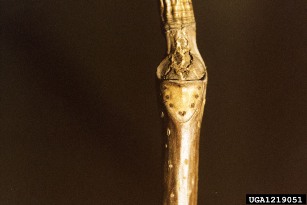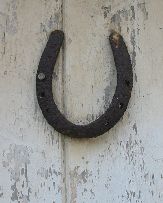Nutrition
Primarily, horse chestnuts receives nutrition from
the photosynthesis it undergoes. The complexity of
photosynthesis can be summarized in one simple equation:

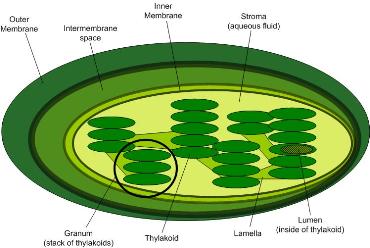
So,
where does this happen?
The conversion in this equation takes place in the chloroplasts
of the plant. This organelle is easily identified by the
green pigment, chlorophyll, located within. The
chloroplasts are each made up of a double membrane, containing
an inner and an outer layer, stroma and thylakoids.
Thylakoids consist of membranous sacs that contain the thylakoid
space. These membranes include massive amounts of
chlorophyll. The stroma is simply the fluid in between the
thylakoids. Multiple chloroplasts come together to make
up what is called a mesophyll cell, which consequently make up
the mesophyll layer of the leaf.
So, how do these chloroplasts obtain Carbon dioxide,
water and light?
 Carbon dioxide is obtained from the surrounding atmosphere and
taken in through pores in the
epidermis of the leaves called
stomata. This carbon dioxide passes through the stomata
based on its partial pressure gradient, fundamentally the
difference in the amount of carbon dioxide in the atmosphere and
inside the leaf. The main complication in obtaining this
gas exchange is the unavoidable loss of water that occurs due to
the stomata opening. However, this process is relatively
simple due to the small distance that has to be traveled by
carbon dioxide to the chloroplasts.
Carbon dioxide is obtained from the surrounding atmosphere and
taken in through pores in the
epidermis of the leaves called
stomata. This carbon dioxide passes through the stomata
based on its partial pressure gradient, fundamentally the
difference in the amount of carbon dioxide in the atmosphere and
inside the leaf. The main complication in obtaining this
gas exchange is the unavoidable loss of water that occurs due to
the stomata opening. However, this process is relatively
simple due to the small distance that has to be traveled by
carbon dioxide to the chloroplasts.
In contrast, water is primarily obtained from the ground by the
roots of the tree and is forced to travel to sites with
chloroplasts.
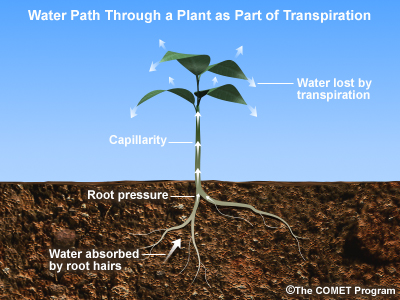 The
first step in this process for water is obtaining access to the
transport vessels (xylem). The water starts by entering
the roots through extensions of the epidermis called root hairs
or simple diffusion across the epidermal layer. The water
molecules then continue into the cortex of the root until it
reaches the Casparian strip
located in the endodermis cell layer of the root. This
waxy strip forces the water molecules to cross the membrane of
the endodermis cells. The water molecules are forced to
take the
symplastic route, a very important aspect to ensure
that no air bubbles can gain entry into the xylem. The
second step in the process is for the water to move successfully
from the roots to the rest of the tree. Four factors are
responsible for this movement: transpiration , adhesion,
cohesion, and tension. Water molecules hydrogen bond with
themselves and the walls of the xylem, resulting in a strand of
connected water. As water is lost from the leaves a
negative pressure is created that pulls the column of water
molecules up the vessel. Lastly, light is simply obtained
from either genuine or artificial sunlight.
The
first step in this process for water is obtaining access to the
transport vessels (xylem). The water starts by entering
the roots through extensions of the epidermis called root hairs
or simple diffusion across the epidermal layer. The water
molecules then continue into the cortex of the root until it
reaches the Casparian strip
located in the endodermis cell layer of the root. This
waxy strip forces the water molecules to cross the membrane of
the endodermis cells. The water molecules are forced to
take the
symplastic route, a very important aspect to ensure
that no air bubbles can gain entry into the xylem. The
second step in the process is for the water to move successfully
from the roots to the rest of the tree. Four factors are
responsible for this movement: transpiration , adhesion,
cohesion, and tension. Water molecules hydrogen bond with
themselves and the walls of the xylem, resulting in a strand of
connected water. As water is lost from the leaves a
negative pressure is created that pulls the column of water
molecules up the vessel. Lastly, light is simply obtained
from either genuine or artificial sunlight.
So, how exactly are sugar and oxygen produced?
The complex process of photosynthesis can be divided up into two
cycles, the light reactions and the Calvin cycle.
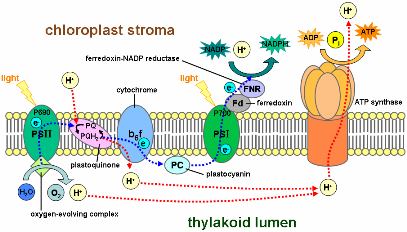 The
purpose of the light reactions is to convert the solar energy
that is acquired by the plant into chemical energy that can be
used towards the Calvin cycle. First, water molecules are
each split into two hydrogen ions, 2 electrons and an oxygen
molecule. When light hits the chlorophyll in Photosystem
II, the supplied electrons are excited and passed down membrane
proteins to Photosystem I. When light hits the chlorophyll
in Photosystem I, the recieved electrons are again excited and
continue through more membrane proteins until it reaches NADP+
reductase. At this point the excited electrons are joined
by NADP+ and a hydrogen ion from the Calvin cycle to form NADPH.
At the same time the hydrogen ions from water splitting along
(along with hydrogen ions from other sources) form a
concentration gradient inside the thylakoid space. These
ions exit the thylakoid through an enzyme called ATP synthase,
allowing for the creation of ATP. The byproduct of this
reaction is oxygen and the generated ATP and NADPH are utilized
in the next cycle.
The
purpose of the light reactions is to convert the solar energy
that is acquired by the plant into chemical energy that can be
used towards the Calvin cycle. First, water molecules are
each split into two hydrogen ions, 2 electrons and an oxygen
molecule. When light hits the chlorophyll in Photosystem
II, the supplied electrons are excited and passed down membrane
proteins to Photosystem I. When light hits the chlorophyll
in Photosystem I, the recieved electrons are again excited and
continue through more membrane proteins until it reaches NADP+
reductase. At this point the excited electrons are joined
by NADP+ and a hydrogen ion from the Calvin cycle to form NADPH.
At the same time the hydrogen ions from water splitting along
(along with hydrogen ions from other sources) form a
concentration gradient inside the thylakoid space. These
ions exit the thylakoid through an enzyme called ATP synthase,
allowing for the creation of ATP. The byproduct of this
reaction is oxygen and the generated ATP and NADPH are utilized
in the next cycle.
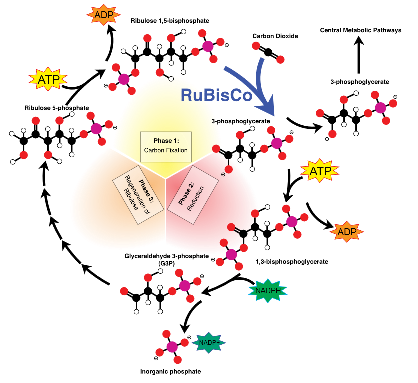
In a nutshell the Calvin cycle uses carbon dioxide from the air
and ATP and NADPH from the light reactions to create glucose.
The diagram to the right shows more detail to each phase, but
this cycle can be divided up into three phases. The first
phase is carbon fixation. Each carbon dioxide molecule is
attached to RuBP, a five carbon sugar, by an enzyme called
rubisco. The process utilizes 6 ATP and 6 NADPH before it
forms two molecules of 3-phosphoglycerate.The next phase,
reduction, actually creates the three-carbon sugar used to form
the sugar. During this phase each molecule of
3-phosphoglycerate receives a phosphate group and a pair of
electrons. Each carbon dioxide molecule yields 6 of these
three-carbon sugars, but 5 of them are recycled into the third
phase without being processed into glucose. This last
phase utilizes 3 ATP to reform the RuBP that is attached to
carbon dioxide in the first phase.
So, how is this generated sugar transported throughout
the tree?
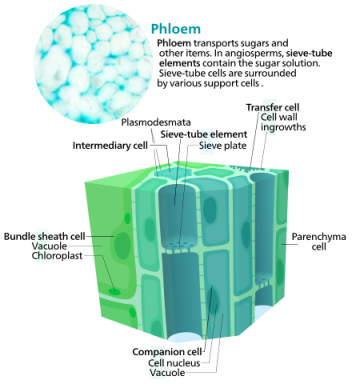 The generated sugars are carried as part of the phloem
sap along with amino acids, hormones, and minerals. This
sap moves from sites of sugar production, called sources, to
sites of sugar use or storage, called sinks. From the
chloroplast, the sugar enters into the sieve tube members of the
phloem. In this process, the increase of sugar inside the
sieve tube creates a water gradient, forcing water to enter the
sieve-tube at the site of the source. The positive
pressure that is consequently generated functions to transport
the sugar to an area of lower sugar concentration, the sink.
Therefore, this movement of sugar from source to sink cells
using the phloem can occur in any direction in the tree.
The sieve-tube elements lack a nucleus at maturity and therefore
need other cells to aid in the function of the phloem.
Therefore to the left you will see a diagram of phloem also
including nucleated companion cells and parenchyma cells.
The generated sugars are carried as part of the phloem
sap along with amino acids, hormones, and minerals. This
sap moves from sites of sugar production, called sources, to
sites of sugar use or storage, called sinks. From the
chloroplast, the sugar enters into the sieve tube members of the
phloem. In this process, the increase of sugar inside the
sieve tube creates a water gradient, forcing water to enter the
sieve-tube at the site of the source. The positive
pressure that is consequently generated functions to transport
the sugar to an area of lower sugar concentration, the sink.
Therefore, this movement of sugar from source to sink cells
using the phloem can occur in any direction in the tree.
The sieve-tube elements lack a nucleus at maturity and therefore
need other cells to aid in the function of the phloem.
Therefore to the left you will see a diagram of phloem also
including nucleated companion cells and parenchyma cells.
If you would like to learn about another photosynthetic organism
visit
Cymbopogon citratus. Also! If you would like to explore
an organism with a completely different method for obtaining
nutrients visit
Brevibacterium linens.
